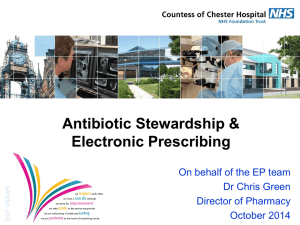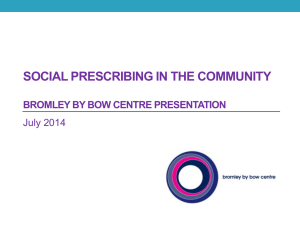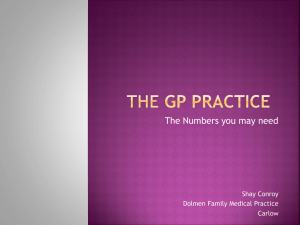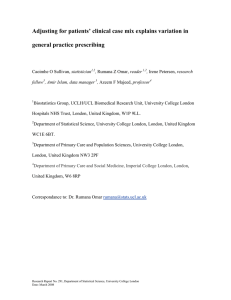3.50 Integrating Administrative Data in Health Studies: A case study
advertisement
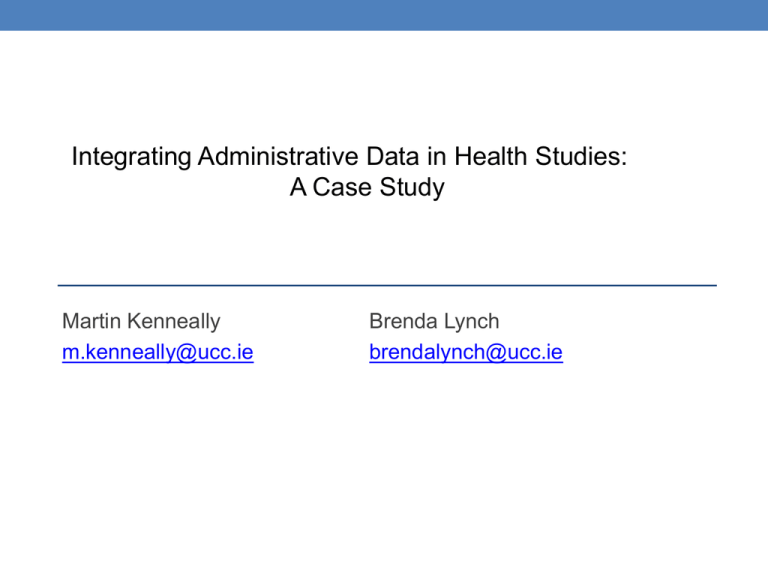
Integrating Administrative Data in Health Studies: A Case Study Martin Kenneally m.kenneally@ucc.ie Brenda Lynch brendalynch@ucc.ie Objectives • Profile the Health Status of Irish Regions (2010) • Link Regional Health Profiles to Regional Prescribing. • Incorporate Regional Demographics, Community Drug Scheme Coverage rates and Prescribing Norms • Simulate effects of Health Status, GMS coverage & Demographics on Prescribing Rates & Cost outcomes. • Identify correlates of health status Profile Regional Health Status • Construct a Composite Health Index to; • (a) Calibrate the health status of 8 Irish regions below • (b) Use Ireland as Standard with base value of 100. Regions Counties 1. East Dublin Kildare Wicklow 2. Midlands Laois Offaly Longford 3. Mid West Clare Limerick N Tipperary 4. North East Cavan Louth Meath 5. North West Donegal Leitrim Sligo 6. South East Carlow Kilkenny S Tipperary 7. South West Cork Kerry 8. West Galway Mayo Roscommon W. Meath Monaghan Waterford & Wexford Profiling Steps 1. Select Health Indicators: (mainly morbidity rates) for each type of major health condition 2. Standardized Rates = national/regional morbidity rate *100 3. Aggregate Rates: using Prescription Weights. 3(a) Aggregate separately for GMS, DP and LTI drug schemes in each region. 3(b) Then Aggregate across schemes in a region (using coverage weights) to obtain that region’s Regional Health Index • (i) Use Index to Benchmark Regional Health Status • (ii) Use Index to Benchmark Regional Health Gaps • (iii) Simulate selected policy outcomes • (iv) Identify Correlates of Health Status & Health Gaps Official/Administrative Datasets Available • Official: CSO e.g. QNHS – Health Module (Used) • Admin: non-CSO, respondent centred, dedicated focus e.g. • IPH: General. Morbidity Prevalence Rates by County (Used) • PCRS: Drug Scheme Coverage & Prescribing data (Used) • Health Atlas: Focus on Public Patients • Tilda: Focus on Over 50s (Ageing) • SLAN: Focus on Lifestyle, Attitudes & Nutrition. Periodic. • CME: General, 2008/9 only [BNF not ICD codes used]. Technical Challenges • Missing Definitions, sources and methods • Disjoint Definitions/Concepts e.g. CSO vs PCRS ‘regions’ Health Data Gaps QNHS Health Module covers 19 Health Conditions: (i) ‘Adults only’ (excludes under 18s) (ii) Rates refer to “at any time in a respondent’s past” (iii) Excludes GERD & pregnancy/immunization services and (iv) Does not cross-tabulate conditions by region/medical cover. PCRS: Publishes prescribing by scheme, region, age & gender but does not publish allied morbidity rates on the same basis. Upshot, we don’t know; (i) How much morbidity rates of ‘public’ & ‘private’ patients differ (ii) How much GP visit rates reflect ill-health v’s type of health cover (iii) How much prescribing rates reflect ill-health v’s health cover Community Drug Schemes Incorporated Incorporated • 1. GMS (General Medical Services) Means tested. Income adjusted for mortgage/housing, childcare, travel costs, savings etc. Discretionary Medical Card also granted to avoid “undue hardship”. • 2. DP (Drug Payment Scheme) – Not means tested. Person/family pays first €144/month; HSE pays any excess • 3. LTI (Long Term Illness) Not means tested. Schedule includes - Cerebral Palsy, Spina Bifida, Epilepsy Acute Leukaemia, Multiple Sclerosis, Diabetes & *************************************************************************************** Not incorporated • HTD (High Tech Drug Scheme) – mainly hospital originated anti-rejection drugs for transplants and chemotherapy Regional Population % Covered by Each Scheme in 2010 GMS DP LTI HTD All 35 61 3 1 100 1.East 28 67 4 1 2. Midlands 38 58 3 1 3. Mid-West 38 59 2 1 4. North-East 38 58 3 1 5. North-West 49 47 3 1 6. South-East 41 55 3 1 7. South 36 61 2 1 8. West 41 56 2 1 Ireland 100 100 100 100 100 100 100 100 Methodology 1) Select 28 health indicators (18 prevalence rates/10 others) 2) Assign to 6 ATC Health Categories/Dimensions: Alimentary, Cardio, CNS, Respiratory, Various & Other 3) Break down 6 ATC categories into 24 Therapeutic Drug Groups 4) Construct (prescription weighted) Composite Health Indices for the 6 ATC categories under each scheme in each region. 5) Aggregate scheme-specific Indices into Regional Indices (using scheme coverage weights). Base Value is Ireland = 100 KL Composite Health Index Index 115 110 105 100 95 90 85 80 Midlands 91.89 North West West - 96.52 94.04 South East 97.05 Republic of Ireland - 100 South 100.48 North East 102.31 Mid West 103.92 Region East - 106.14 Largest Health Gaps by ATC Category Index 135 130 Mid West - 129.56 125 120 115 North East - 108.25 110 East - 104.39 105 East - 105.50 ROI - 100 Best Health Worst Health East - 107.91 West - 102.26 100 ROI - 100 Mid - 92.91 95 90 Mid-West - 95.76 Mid - 95.15 North West - 91.28 Mid - 86.87 85 Mid - 84.97 80 75 70 VARIOUS ALIMENTARY TRACT NERVOUS SYSTEM OTHER CARDIOVASCULAR RESPIRATORY SYSTEM ATC Category Health Gaps & Weights in East & Midlands Regions % 30 20 22.93 10 10.79 4.75 13.10 14.22 5.85 0 12.85 Absolute difference between East's CHI and Midland's CHI 7.99 2.46 16.58 -10 26.02 32.54 -20 National ATC % Weighting -30 -40 ALIMENTARY TRACT VARIOUS NERVOUS SYSTEM OTHER RESPIRATORY SYSTEM CARDIOVASCULAR ATC Category Simulated Prescribing & Cost Outcomes • We constructed & validated a simulation model. • Simulation Model incorporates regional health status, scheme coverage & prescribing norms; • Simulates number & type of drug prescribed in each region in 2010 with high (97%) accuracy • Prescribing semi-elasticity w.r.t. GMS coverage is twice semi- elasticity w.r.t. health-status • Pattern and causes of regional unit drug cost variations still under investigation. Income, Demographics, Coverage & Health Status Region CSO Disposable Percentage Aged % Covered by Income 2010 over 65 GMS Composite Health Index East 20,300 10.00% 28% 106.14 Republic of Ireland 19,300 11.10% 35% 100.00 South 19,200 12.00% 36% 100.48 Mid West 19,100 11.80% 38% 103.92 West 18,500 12.30% 41% 96.52 South East 18,100 12.00% 41% 97.05 North East 17,300 10.00% 38% 102.31 North West 17,300 13.00% 49% 94.04 Midlands 17,100 11.00% 38% 91.89 Unanswered Questions & Policy Issues 1) Macro-causality pattern of regional health status remains “Smudged” 2) “Ground-clearing”: lacking the with precision of, say, Kabir et al. 2013 on CHD 3) North-West v’s North East (for example): • Why is GMS cover in NW so much higher? (Equity) • Is poorer NW health status due to poor demographics? • How much do other factors contribute to health status? Recommendations to Increase Usability • Working Party of Official & Admin Groups to Agree; • Common and individual domains • Common base observation unit (e.g. DEDs for SAPS & Census) • Common publication unit (NUTS3 or NUTS4) • Harmonised methodologies. • ‘Definitions, Sources and Methods’ manual (IPH/PCRS) • Linked prescribing and morbidity data (for policy analysis) • Published accessible anonymised (Statbank style) Archive Tables • Increased professional statistical input • The End


